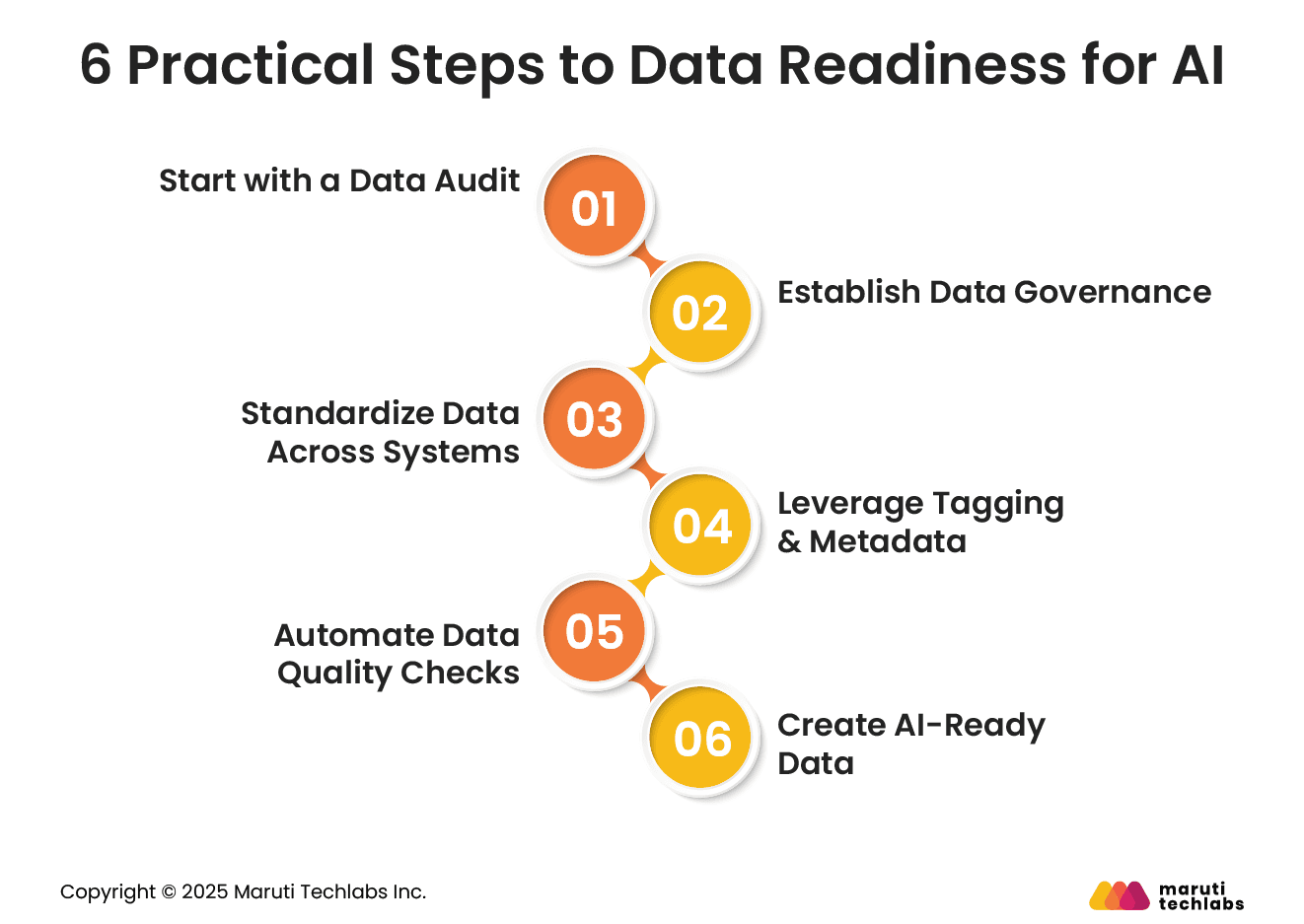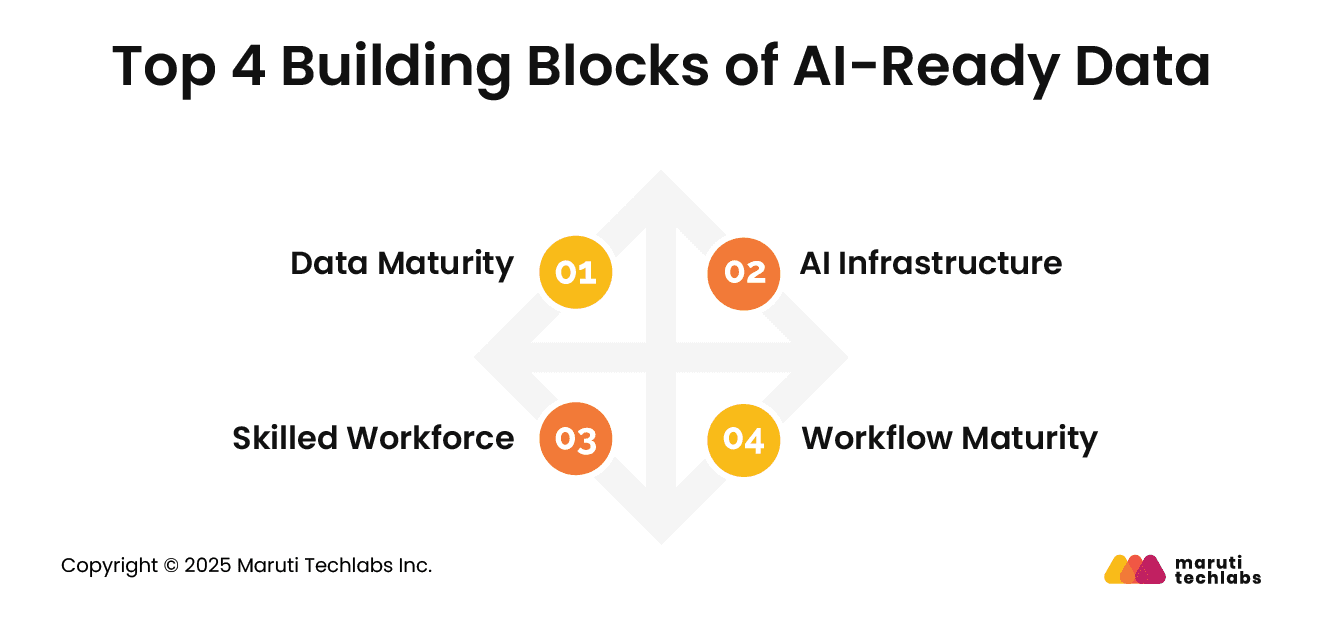

How to Build a Data Framework That Powers AI Adoption: 6 Steps






Generative AI is unlocking unprecedented opportunities, transforming how businesses innovate, engage customers, and make decisions. However, an AI strategy without a strong data framework is just a wish list.
Success with AI doesn’t start with the model; it starts with the data foundation. Organizations eager to harness AI’s potential must first ensure their data is accurate, unified, and governed.
AI-ready data enables seamless integration across systems, reduces bias, and improves decision quality.
This blog will explore the building blocks of data readiness, from assessing data maturity and governance to improving process workflows. It will help you learn how to identify signs that your data is truly AI-ready, and why investing in data quality today determines your success with your AI systems tomorrow.
AI systems are only as adept as the data they are fed. Even the most advanced LLMs can produce incorrect outputs when the data they are fed is outdated, inaccurate, or incomplete.
An AI readiness assessment can paint a complete picture of your data, what can be used, and what needs to be fixed.
A Gartner report states that 85% of AI projects will deliver erroneous outcomes due to bias in data, algorithms, or the teams responsible for managing them.
The consequences of failing AI projects can be costly. This includes:
AI readiness is crucial as it denotes whether your project will be a success or a costly distraction.
Data readiness is primitive to ensuring success with AI projects. Before deciding on models, tools, or automation, a company needs to determine if it has filtered data suitable for its purpose.
AI-ready data doesn’t mean developing the best GenAI tool or foundational model, but the confidence that your data is ready to support it.
Here’s what being AI-ready means:
AI systems become hyped projects without laying this foundation. However, with data readiness, AI can offer actual value and drive confident decisions.
While B2B companies are highly enthusiastic about AI and what it offers, they neglect the basics: filtered, structured, and compliant data.
To make this process easier, here is a 6-step framework to help organizations become AI-ready.

Before you dive into implementation, it’s essential to understand what truly makes data AI-ready. Here are some specific areas your business should focus on to improve AI readiness.
Mature data is a primary requirement for developing AI systems. The absence of well-organized, accurate, and high-quality data can affect even the most sophisticated algorithms.
Proper infrastructure, including hardware and software, is essential for your AI systems to function correctly. This includes platforms and security systems that foster efficient AI use and integration with current systems.

People and AI are equally responsible for a smooth AI adoption. A skilled workforce is concerned with individuals who understand the reasons for AI adoption, its capabilities and limitations, and their willingness to adapt.
Your organization can make the best use of AI with processes that are defined, consistent, and measurable. This refers to clearly documented ways to conclude tasks and to tools for tracking their performance metrics.
Here is how companies can improve AI readiness in 3 phases.
The story of any successful AI implementation begins with a stringent assessment of data readiness. Cultivating this Data First mindset can help ask essential questions, like whether the data is accessible. Is the data accurate?
Upon completing the assessment, organizations should analyze key areas for improvement. This can include refining specific datasets, implementing data governance, or figuring out integration. Observing these practices can pave the way to what “AI-Ready” data looks like.
Additionally, much of your heavy lifting can be done with a unified data management solution, such as a Customer Data Platform (CDP). By leveraging technology, processes, and expertise, any organization can transform its data, laying the foundation for reliable AI systems.
AI success begins with data readiness, not haste. A thorough readiness assessment transforms AI adoption from a risky experiment into a strategic advantage.
By putting Data First, organizations create a strong foundation that supports scalability, innovation, and long-term impact. Workflow automation provides an ideal proving ground, allowing teams to test, learn, and demonstrate tangible results while building confidence in technology-driven change.
If you’re commencing your AI journey, starting small with high-impact automation initiatives can help your business strengthen its data practices and operational maturity. With this approach, you can move from experimentation to sustainable transformation, ready to fully harness the power and promise of AI for the future.
The AI Readiness Calculator from Maruti Techlabs helps organizations assess their readiness to adopt and scale AI. Evaluating key areas such as data, technology, people, and processes, it provides actionable insights to close readiness gaps, empowering businesses to make smarter investments and accelerate AI-driven transformation. As part of this foundation, their comprehensive AI Strategy & Readiness services further support organizations in aligning vision, governance, and execution for long-term AI success.
Connect with us today to learn more about how our experts can help your business create the perfect AI ecosystem that drives sustainable growth and maximizes business value.
To make data AI-ready, ensure it is accurate, consistent, complete, and well governed. Standardize formats, remove duplicates, and maintain clear data lineage. High-quality data enables reliable insights, reduces bias, and ensures that AI models deliver meaningful and trustworthy outcomes.
Assess data quality, availability, and relevance to your business goals. Evaluate if the data is clean, structured, and sufficient for training models. Use a readiness framework to identify gaps in governance, labeling, and integration to ensure smooth deployment of machine learning solutions.
AI-ready data follows six principles: accuracy, consistency, completeness, accessibility, governance, and relevance. These principles ensure data is trustworthy, easy to integrate, and aligned with organizational objectives, enabling efficient training, unbiased predictions, and scalable implementation of artificial intelligence systems.


